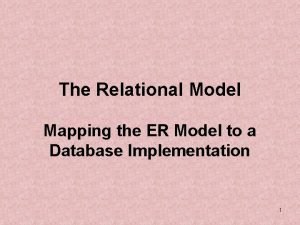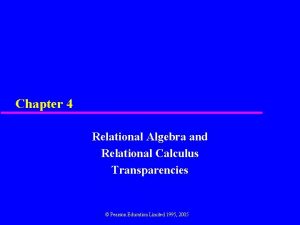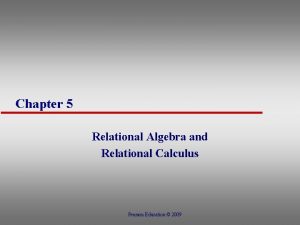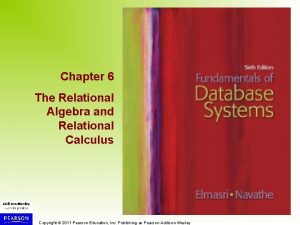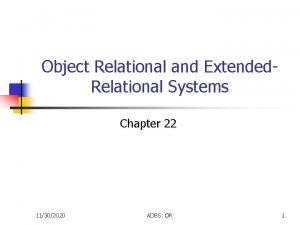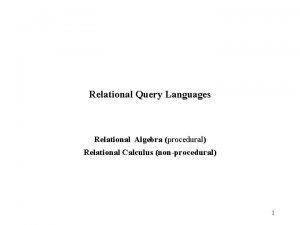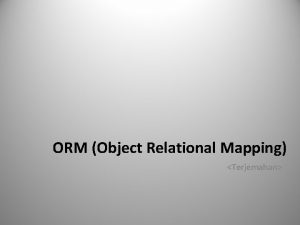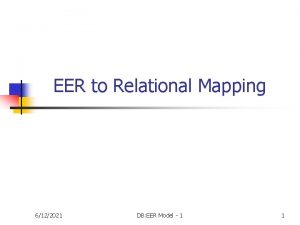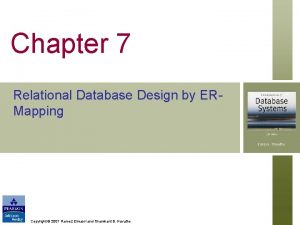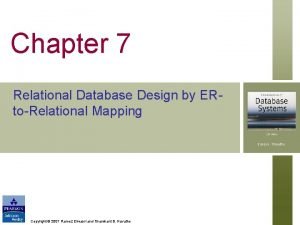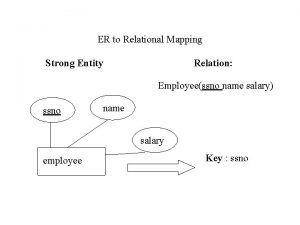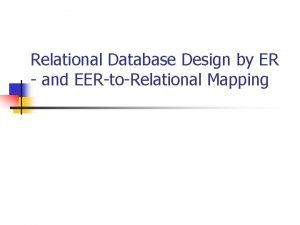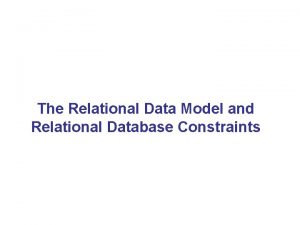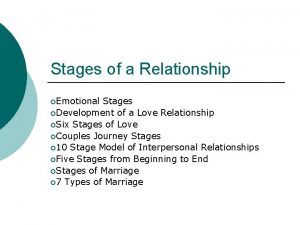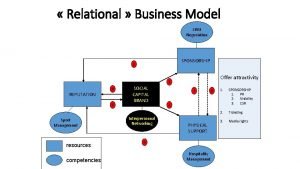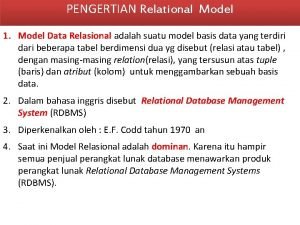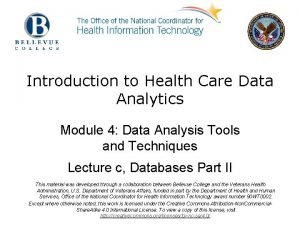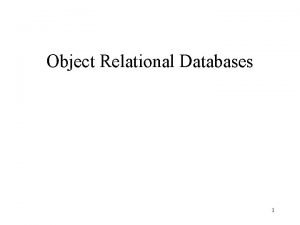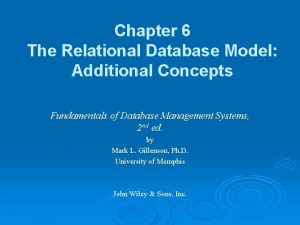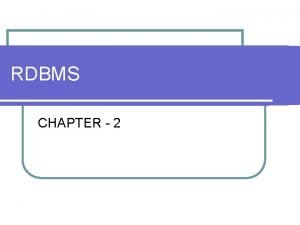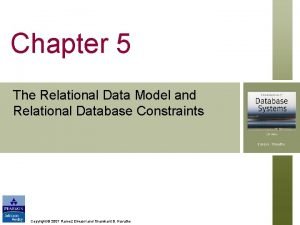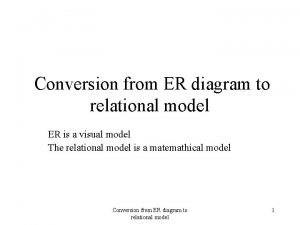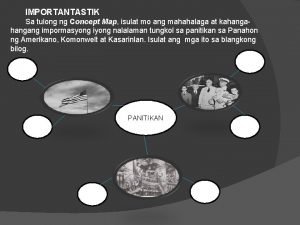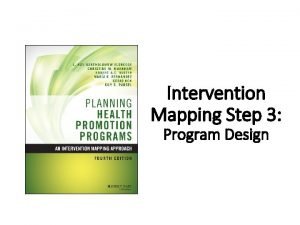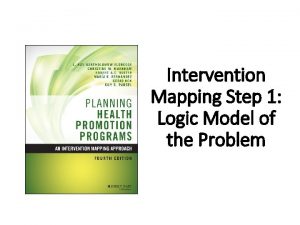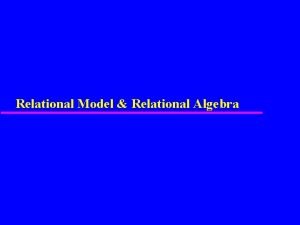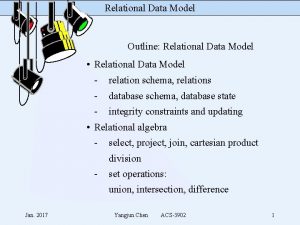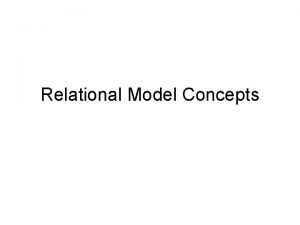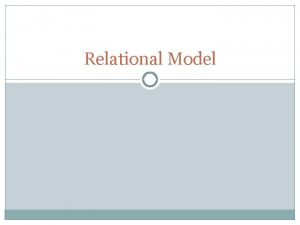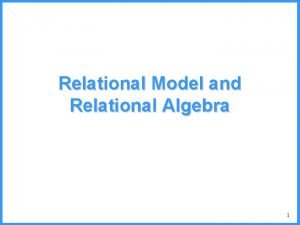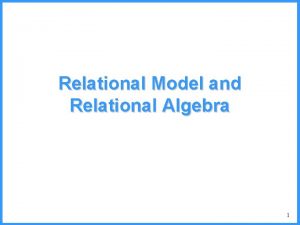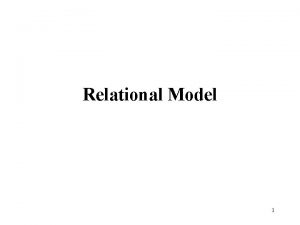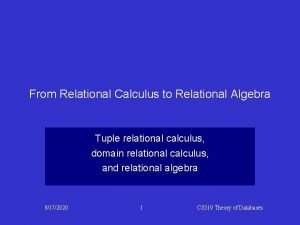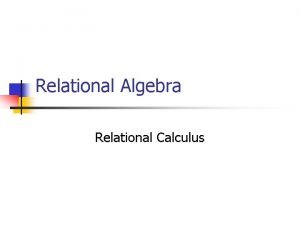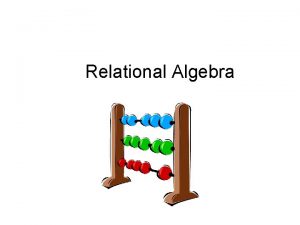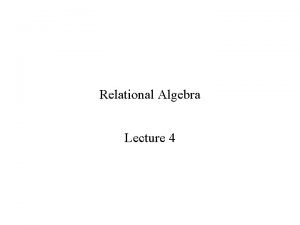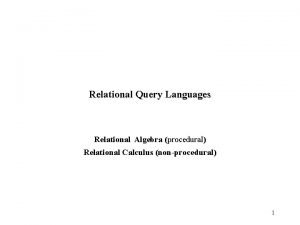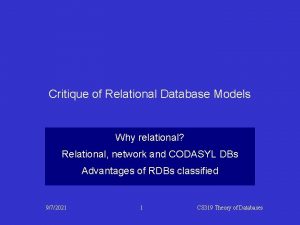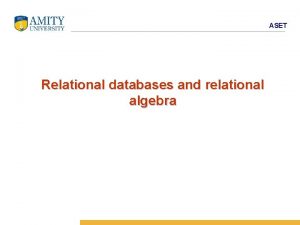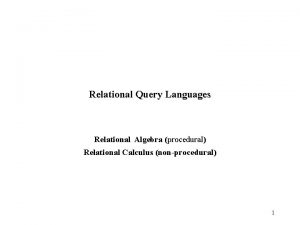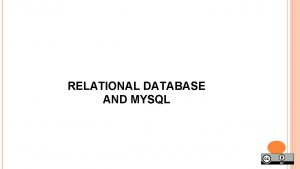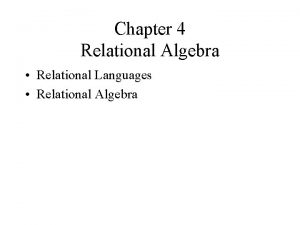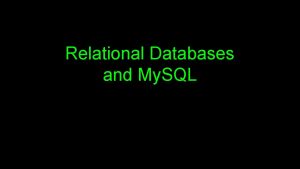The Relational Model Mapping the ER Model to









































- Slides: 41

The Relational Model Mapping the ER Model to a Database Implementation 1

The Relational Model • Mathematically based • Can develop theoretical design improvements & enhancements that result in applications to many different applications • Can use exact mathematical notation • Basic structure is simple, easy to understand – Separates logical from physical level – Operations do not require user to know storage structures used – Data operations easy to express, using a few powerful commands 2

Tables • Relations are represented logically as tables – Tables are related to one another – Table holds information about entities • Table rows correspond to individual records • Table columns correspond to attributes – A column contains values from one domain – Domains consist of atomic (single) values 3

Properties of Tables • Each cell contains at most one value – It is a single piece of data • Each column has a distinct name – This is the name of the attribute it represents • Values in a column all come from the same domain • Each tuple is distinct – no duplicate tuples 4

Sample: ER to Relational Model Enrolls STUDENT Taught by CLASS Student Enroll Class stu. Id last. Name first. Name major credits stu. Id S 1001 Smith Tom History 90 S 1001 ART 103 A A S 1002 Chin Ann Math 36 S 1001 HST 205 A C S 1005 Lee Perry History 3 S 1002 ART 103 A D S 1010 Burns Edward Art 63 S 1002 CSC 201 A F S 1013 Mc. Carthy Owen Math 0 S 1002 MTH 103 C B S 1015 Jones Mary Math 42 S 1010 S 1020 Rivera Jane CSC 15 Faculty fac. Id name department rank F 101 Adams Art Professo r F 105 Tanak a CSC Instructo r F 110 Byrne Math Assistan t F 115 Smith History Associat e F 221 Smith CSC Professo class. Num FACULTY grade class. Num fac. Id schedule room ART 103 A F 101 MWF 9 H 221 CSC 201 A F 105 Tu. Th. F 10 M 110 CSC 203 A F 105 MTh. F 12 M 110 HST 205 A F 115 MWF 11 H 221 ART 103 A MTH 101 B F 110 MTu. Th 9 H 225 S 1010 MTH 103 C F 110 MWF 11 H 225 S 1020 CSC 201 A B S 1020 MTH 101 B A Student (stu. Id, last. Name, first. Name, major, credits) Class (class. Num, fac. Id, schedule, room) Faculty (fac. Id, name, department, rank) Enroll(stu. Id, class. Num, grade) 5

Representing Relational Database Schemas • Can have any number of relation schemas • Example: University database schema Student (stu. Id, last. Name, first. Name, major, credits) Class (class. Number, fac. Id, schedule, room) Faculty (fac. Id, name, department, rank) Enroll(stu. Id, class. Number, grade) • This could also be represented by the relationships screen of the DBMS. 6

Properties of Relations (Tables) • Degree: the number of attributes – Binary, ternary, n-ary • Connectivity: – 1: 1, 1: N, M: N • Cardinality: the number of tuples – Changes as tuples are added or deleted • Keys • Constraints 7

Keys • Relations never have duplicate tuples (rows) – You can always tell tuples apart / there is always a key • Superkey: set of attributes that uniquely identifies tuples • Candidate key: minimal superkey – No proper subset of itself is also a superkey • Primary key (PK): candidate key chosen to uniquely identify tuples – You cannot verify a key by looking at an instance – why? • Foreign key (FK) is an attribute or combination of attributes of a relation that is the PK of another relation 8

Selecting the Primary Key • An ideal primary key is short, numeric, and seldom changing • If there is more than one candidate key, each should be carefully evaluated • If the entity has no identifier, some attribute must be selected as the PK – In some situations, a surrogate key may be defined 9

Surrogate Keys • These are unique, DBMS-supplied identifiers used as the PK of a relation • The values of a surrogate key have no meaning to users and are normally hidden on forms and reports • The DBMS does not allow the value of a surrogate key to be changed • Disadvantages: – FK’s based on surrogate keys have no meaning to users – When data shared among different databases contain the same ID, merging those tables might yield unexpected results 10

Constraints • Integrity constraints – to ensure “correctness and internal consistency” – Rules or restrictions that apply to all instances of the database – Enforcing them ensures only legal states of the database are created • Types of integrity constraints – Domain constraint - limits set of values for an attribute – Entity integrity - no part of a PK can be null – Referential integrity - each FK value must match the primary key value of some tuple in its related relation, or be null • General constraints are the business rules – These may be expressed as table constraints or assertions • Participation constraints reflect the extent of entities’ involvement in given relationships 11

The Database Implementation Process • This is the step in the database design process that follows the conceptual design/ERD – Create tables and columns from entities and attributes – Select primary keys – Represent relationships – Specify constraints – Performance tuning 12

Mapping the ERD to a Relational Model • Entities – Issues with composite & multi-valued attributes – Issues with weak entities • Relationships – 1: 1, 1: N and M: N – Participation constraints 13

Mapping an Entity to a Table • Each entity maps onto a table – Its non-composite, single-valued attributes comprise the table’s column headings – For composite attributes, there are 3 possible ways: • Make the composite into a single attribute • Create several individual attributes to replace the composite • Create a new entity – For multi-valued attributes, we create a new table • The PK of this new table is the composite of the original attribute coupled with the PK of the original table • This new table is created as a weak entity – Example: multiple email accounts 14

Mapping a Relationship • Binary Relationships: – 1: M • PK of 1 -side becomes a FK of the M-side table – 1: 1 • First, make sure they are not the same entity. If not, use either PK as the FK in the other table – M: M • Create a relationship table (bridge, composite) with a composite PK consisting of the PK’s of the related entities, along with any relationship attributes • Ternary or higher degree relationships: construct relationship table of keys, along with any relationship attributes • With all relationships, we must preserve referential integrity, participation & cardinality constraints 15

1: 1 Relationship EMPLOYEE 1 Has 1 AUTO 16

1: N Relationship 1 FACULTY N Teaches CLASS Class Faculty fac. Id name department rank F 101 Adams Art Professo r class. Num fac. Id schedule room ART 103 A F 101 MWF 9 H 221 CSC 201 A F 105 Tu. Th. F 10 M 110 F 105 Tanak a CSC Instructo r CSC 203 A F 105 MTh. F 12 M 110 F 110 Byrne Math Assistan t HST 205 A F 115 MWF 11 H 221 F 115 Smith History Associat e MTH 101 B F 110 MTu. Th 9 H 225 F 221 Smith CSC Professo r MTH 103 C F 110 MWF 11 H 225 17

M: N Relationship Enrolls STUDENT CLASS Student Enroll class. Num Class stu. Id last. Name first. Name major credits stu. Id grade S 1001 Smith Tom History 90 S 1001 ART 103 A A S 1002 Chin Ann Math 36 S 1001 HST 205 A C S 1005 Lee Perry History 3 S 1002 ART 103 A D S 1010 Burns Edward Art 63 S 1002 CSC 201 A F S 1013 Mc. Carthy Owen Math 0 S 1002 MTH 103 C B S 1015 Jones Mary Math 42 S 1010 S 1020 Rivera Jane CSC 15 class. Num fac. Id schedule room ART 103 A F 101 MWF 9 H 221 CSC 201 A F 105 Tu. Th. F 10 M 110 CSC 203 A F 105 MTh. F 12 M 110 HST 205 A F 115 MWF 11 H 221 ART 103 A MTH 101 B F 110 MTu. Th 9 H 225 S 1010 MTH 103 C F 110 MWF 11 H 225 S 1020 CSC 201 A B S 1020 MTH 101 B A Student (stu. Id, last. Name, first. Name, major, credits) Enroll(stu. Id, class. Num, grade) Class (class. Num, fac. Id, schedule, room) 18

Weak entities • Weak entities become tables by adding the PK of the parent (strong) entity – What is the primary key in such a table? • What about the total participation (and existence dependence) constraint? – What do we need to ensure? – How do we do this? 19

RDBMS Rules Regarding FK’s • Choices made when relationships are established between tables – Cascade deletes • If parent instance is deleted, so are all its children – Restrict deletes • Cannot delete a parent instance if it has a child – Set to NULL • If parent instance is deleted, set the FK of the child to NULL – Cascade updates • If parent instance gets new PK, change the FK of all its children 20

Total participation • Referential integrity actions need to be specified to ensure that – When the parent entity instance is deleted, the weak entity instance is deleted as well – Each new weak entity instance must have a parent instance with which to connect • Other participation situations also require careful attention. – They must be reasoned out. 21

Weak Entity Example 22

Enforcing Minimum Cardinality • If the minimum cardinality on the child is 1, at least one child row must be connected to the parent • A required parent can be specified by making the foreign key value NOT NULL • A required child can be represented by creating update and delete referential integrity actions on the child and insert referential integrity actions on the parent • Such referential integrity actions must be declared during database design and trigger codes must be written during implementation 23

Subtype Relationship 24

Entity Supertypes and Subtypes • Generalization hierarchy – Depicts a relationship between a higherlevel supertype entity and a lower-level subtype entity • Supertype entity – Contains shared attributes • Subtype entity – Contains unique attributes 25

Nulls Created with No Supertypes/Subtypes 26

A Generalization Hierarchy 27

Disjoint Subtypes • Also known as non-overlapping subtypes – Subtypes that contain a subset of the supertype entity set – Each entity instance (row) of the supertype can appear in only one of the disjoint subtypes • Supertype and its subtype(s) maintain a 1: 1 relationship – So, how is it implemented in an rdbms? 28

EMPLOYEE/PILOT Supertype/Subtype Relationship 29

A Generalization Hierarchy with Overlapping Subtypes 30

Recursive Relationships • A recursive relationship is a relationship among entities of the same class • For 1: 1 and 1: N recursive relationships, add a foreign key to the relation that represents the entity 31

1: 1 Recursive Relationships 32

1: N Recursive Relationships 33

Some issues with conceptual design using the ER model • Design choices: – – – • Should a concept be modeled as an entity or an attribute? Should a concept be modeled as an entity or a relationship? Identifying relationships: Binary or ternary? When to allow NULL values? How should privacy concerns/sensitive data collection be handled? Constraints in the ER Model: – – A lot of data semantics can (and should) be captured. But some constraints cannot be captured in ER diagrams. 34

Entity vs. Attribute • Should address be an attribute of EMPLOYEE or an entity (connected to EMPLOYEE by a relationship)? • Depends upon the use we want to make of address data, and the semantics of the data: – If we have several addresses per employee, address must be an entity – If the structure (city, street, etc. ) is important, e. g. , we want to retrieve employees in a given city, address can be modeled as an entity or as several attributes 35

Entity vs. Attribute example • Works_In does not allow an employee to work in a department for two or more periods. • Similar to the problem of wanting to record several addresses for an employee: We want to record several values of the descriptive attributes for each instance of this relationship. • Accomplished by introducing new entity set, Duration. eid to from name lot did Works_In Employees eid name dname lot Employees from budget Departments did Works_In Duration dname budget Departments to 36

Entity vs. Relationship since name • First ER diagram OK if a manager gets a separate discretionary budget for each dept. eid dbudget lot Employee did dname budget Department Manages name • What if a manager gets a discretionary budget that covers all managed depts? Could also be a supertyp e eid lot since Employee Is a Manager Manages dname did budget Department dbudget 37

Binary vs. Ternary Relationships eid name Employee What are the differences between these two diagrams? Covers Design 1 eid age Dependent Policy policyid name pname lot cost pname lot age Dependent Employee Purchaser Beneficiary Design 2 Policy policyid cost 38

Binary vs. Ternary Relationships • An example where a ternary relation is required – Contracts relates entity sets PART, DEPT and SUPPLIER, and has attribute qty. • No combination of binary relationships is an adequate substitute: • S “can-supply” P, D “needs” P, and D “deals-with” S does not imply that D has agreed to buy P from S. • And, furthermore, how would we record qty? 39

Null values • A null value is an attribute value that has not been supplied • Null values are ambiguous as they can mean – The value is unknown – The value is inappropriate – The value is known to be blank • Inappropriate nulls can be avoided by – Defining subtype or category entities – Forcing attribute values through the use of not null – Supplying initial values • Ignore nulls if the ambiguity is not a problem to the users 40

Surrogate Key Example 41
 Mapping of er model to relational model
Mapping of er model to relational model Relational algebra and relational calculus
Relational algebra and relational calculus Relational calculus
Relational calculus Relational algebra and relational calculus
Relational algebra and relational calculus Object relational and extended relational databases
Object relational and extended relational databases Relational calculus is a procedural language
Relational calculus is a procedural language Arti orm
Arti orm Object relational mapping
Object relational mapping Eer
Eer An er schema for a ship_tracking database.
An er schema for a ship_tracking database. Er to relational mapping algorithm
Er to relational mapping algorithm Er to relational mapping example
Er to relational mapping example Er to relational mapping algorithm
Er to relational mapping algorithm Mapping of n-ary relationship types
Mapping of n-ary relationship types Er to relational mapping exercise
Er to relational mapping exercise The associative mapping is costlier than direct mapping.
The associative mapping is costlier than direct mapping. Forward mapping vs backward mapping
Forward mapping vs backward mapping Prinsip analisis dan desain
Prinsip analisis dan desain Relational database constraints
Relational database constraints Relationship growth stages
Relationship growth stages Ducks relationship filtering model
Ducks relationship filtering model Knapp's relationship model
Knapp's relationship model Advantages of relational database model
Advantages of relational database model The logical view
The logical view Relational business model
Relational business model Tupel
Tupel Advantages and disadvantages of data science
Advantages and disadvantages of data science Extended relational data model
Extended relational data model Er diagram hierarchy
Er diagram hierarchy Object-relational model
Object-relational model Primary concepts of the relational database model
Primary concepts of the relational database model Ef codd rules
Ef codd rules Relational model constraints
Relational model constraints Er diagram to relational model conversion
Er diagram to relational model conversion Concept map pananaliksik
Concept map pananaliksik Science mind map examples
Science mind map examples Intervention mapping steps
Intervention mapping steps Logic model of the problem intervention mapping
Logic model of the problem intervention mapping Hình ảnh bộ gõ cơ thể búng tay
Hình ảnh bộ gõ cơ thể búng tay Ng-html
Ng-html Bổ thể
Bổ thể Tỉ lệ cơ thể trẻ em
Tỉ lệ cơ thể trẻ em
